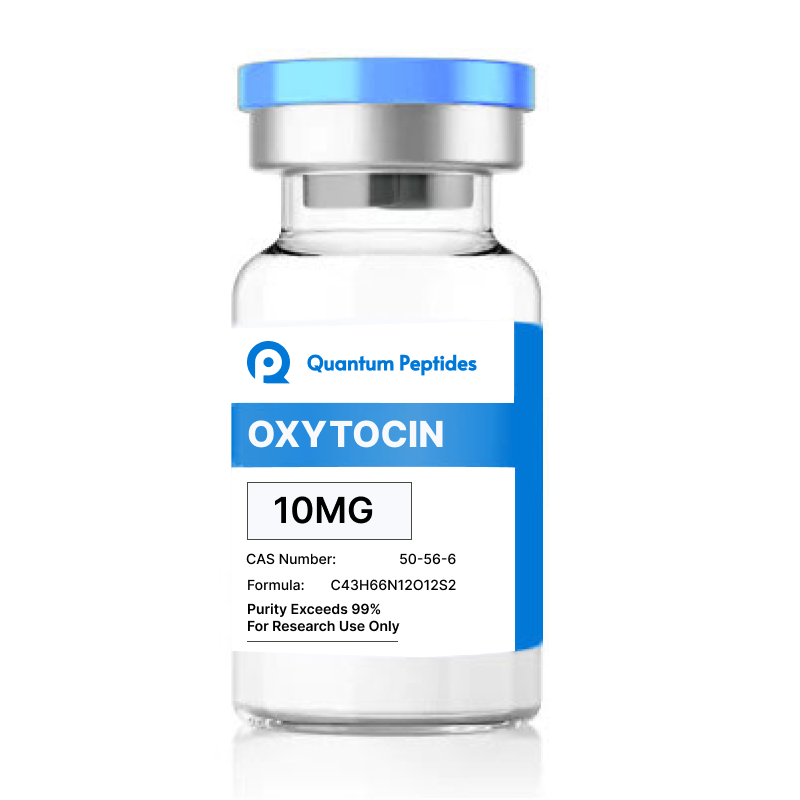Oxytocin (10mg)
$49.00
Melatonin, a hormone produced naturally by the pineal gland, regulates sleep-wake cycles and is involved in circadian rhythms. Recent studies propose that it might have antioxidant properties, support immune function, and mitigate the impacts of neurodegenerative conditions.
Oxytocin: Historical Insights and Structural Development
The peptide hormone Oxytocin, consisting of nine amino acids, was first isolated in 1920, with its structural elucidation occurring in the 1950s. Following these milestones, extensive research studies were undertaken to unravel the characteristics and actions of this naturally occurring cyclic peptide. While scientists attribute its creation to the hypothalamus, Oxytocin is believed to be stored in the posterior pituitary gland and released upon hormonal stimulation. The synthetic counterpart, Recombinant Oxytocin, was developed to mirror the structure of its natural counterpart. Intriguingly, Oxytocin operates through a positive feedback mechanism, distinguishing it from other hormones, as its initial secretion may trigger further releases with increased concentrations and intensity. Both natural and synthetic forms share this distinctive mechanism.
Upon entering the system, Oxytocin engages with G-protein coupled receptors, initiating a cascade that elevates intracellular calcium levels. This surge in calcium appears to play a pivotal role in inducing uterine contractions, particularly during childbirth. Once contractions commence, they trigger additional Oxytocin release, intensifying both the frequency and strength of contractions through a potential positive feedback mechanism. Beyond its role in labor, Oxytocin contributes to myoepithelial cell contractions in the alveolar ducts of breasts. These contractions facilitate the ejection of milk from alveolar ducts into larger sinuses, promoting milk expulsion. In this scenario as well, the positive feedback mechanism may be at play, where initial milk release stimulates further Oxytocin release, ensuring a continuous flow of milk.
Exploration and Scientific Investigations
Clinical Investigations and Oxytocin Peptide
In this clinical exploration(6), the primary objective was to assess the incidence of cesarean delivery in female participants after the cessation of Oxytocin administration upon reaching active labor (5 cm cervical dilation). The study, comprising 252 women aged 18 to 50 years, implemented a randomized clinical trial design. The participants were allocated into two groups: group A (n=127) received continuous peptide administration following the study protocol, even after reaching active labor, while group B (n=125) had Oxytocin discontinued after active labor induction. Within the 24-72 hour study period, group A reported 32 cesarean deliveries, with 10 infants exhibiting one or more abnormalities requiring further observation. In contrast, group B had 24 cesarean deliveries, with 9 infants displaying abnormalities.
Maternal Care and Oxytocin Peptide
The central focus of this investigative study(7) was to assess the impact of the peptide on maternal care, specifically in the context of breastfeeding. Employing a retrospective approach, the study compared 100 female subjects administered Oxytocin during labor with 100 counterparts who were not exposed to the peptide. The duration of breastfeeding served as the key metric. Upon scrutinizing the study outcomes, researchers observed that females receiving Oxytocin exhibited seemingly impaired breastfeeding within the first hour post-delivery. For the initial three months, both groups (27% with Oxytocin, and 14% without) reportedly faced challenges in breastfeeding. However, beyond this period, breastfeeding significantly increased in the Oxytocin-exposed subjects. Researchers attributed the initial breastfeeding challenges to the high pre-gestational body mass index in the test subjects.
Oxytocin Peptide and Cardiovascular Dynamics
The primary objective of this clinical investigation(8) was to assess the impact of the peptide on cardiac function and muscle tone in the heart. The study, comprising 51 pregnant test subjects, segregated them into two groups, with one group receiving Oxytocin and the other a placebo during the initial trimester. Parameters such as heart rate and blood pressure were meticulously documented. The findings indicated that the peptide may potentially demonstrate vasodilatory effects on smaller arteries and peripheral vessels, contributing to an increased left ventricular ejection time.
Oxytocin Peptide and Social Anxiety
The central focus of this clinical investigation(9) was to assess the potential impact of the peptide on individuals dealing with social anxiety. Social anxiety is characterized by intense fear and avoidance of social situations. A total of 59 male subjects, ranging from 6 to 11 years old, were included in the study. Among them, 29 were diagnosed with social anxiety, while the remaining served as control subjects. The study involved measuring plasma levels of Oxytocin, revealing that individuals with social anxiety exhibited lower concentrations of the peptide hormone compared to their healthy counterparts. Upon elevating Oxytocin levels during the study, an improvement in the VABS score (analytic behavior score) was observed in subjects with social anxiety.
Oxytocin Peptide is intended solely for scientific research and laboratory applications. Kindly review and comply with our Terms and Conditions before placing an order.







Reviews
There are no reviews yet.